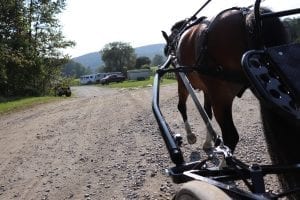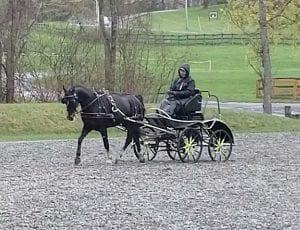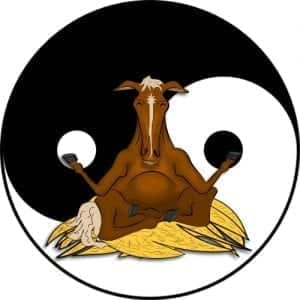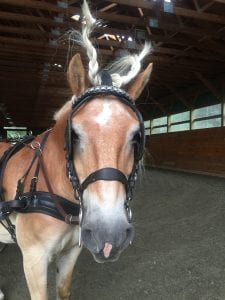 Here’s something I wanted to share with about quitting while I’m ahead. No, I’m not going to quit giving carriage driving lessons or training horses. But I have recently been reminded of a lesson I’ve learned many times over.
Here’s something I wanted to share with about quitting while I’m ahead. No, I’m not going to quit giving carriage driving lessons or training horses. But I have recently been reminded of a lesson I’ve learned many times over.
My Teacher
I have a really fun, interesting, and exciting horse on my regular training schedule. We get to work together 2-3 days a week, in addition to the work that he gets with his person when I’m not there.
Being cute, fancy, and super keen, I’m excited about this horse’s potential. But we’ve had a few less-than-stellar days of training that ended with us returning to the barn tired and frustrated.

Our workouts would start out well enough. His movements would continue on an upward trajectory for a while, but then things would begin to unravel. He’d get tense, begin to rush, then start throwing out one evasion after another.
Sometimes I could “reset” our session by giving him a break. He’s really patient to stand if I need to adjust harness, or explain a concept to my student (a skill that we painstakingly taught him when he arrived) So we’d stand around for 5 or 10 minutes, then return to some stretchy walk, and finally get back to work.
However, when we got back to work, we could only do a small amount of work before the next unraveling began. And when we hit the limit for the second time, the results were even worse than the first. Additionally, it was harder, if not impossible to have another “reset” moment.
A Bridge Too Far
When light finally dawned on marble head, I realized that I’d been ignoring a lesson horses have taught me a hundred times before. More isn’t always better (well, duh!)
It’s easy to fall into the trap of thinking, “Wow, look at what I accomplished with FluffyPants in 40 minutes! If I keep going for another 40 minutes or an hour, I’ll get even more done!”
No. Just… no.
Most of us struggle to get a few days of training each week with their horse. So when the schedule allows, we want to get the most we can out of that time. If things are clicking into place, you just want to keep going.
Unfortunately that assumes that everything will keep clicking into place no matter how long you work your horse. That idea ignores a few basic concepts that contribute to success in your training. Flow state, coordination fatigue, and muscle memory.
The Flow State

As you continue with your workout, you move into either a “building” state where you developing energy in a quiet horse, or a “settling state” for those horses that are more keen. As the energy is shaped into it’s necessary form, your communication improves, and you and your horse enter the “Flow State.”
This is when all the cool stuff happens! Skills you’ve been working on come relatively easily, and new skills can be introduced with minimal resistance. It feels awesome!!
The trouble with the flow state is, it’s limited. You simply can’t sustain a flow state for an indefinite period of time. Here’s why:
Physical Fatigue
We’re all familiar with physical fatigue. When we work our bodies in a physical effort, our muscles get tired. That’s pretty easy to wrap our heads around. We can only run so far before our body will start to shut down, and we’re too tired to run.
Push hard enough, and you’ll get to muscle failure. That’s when your legs turn to Jello, and even walking in a straight line can be difficult. You’re simply experiencing muscle failure in many muscle groups that are responsible for locomotion.
But not all physical fatigue is so obvious. When you are working small muscle groups (such as the ones in your hands), they can reach muscle failure without any physical symptoms.
Likewise, using a large muscle group in a new way (such as your horse’s abdominals) may only produce muscle failure for the new movement, but not old ones. (You’ll understand how that’s a critical failure when you learn more about muscle memory.)
Mental Fatigue

If you’ve been up late studying for an exam, or working long hours our brain gets a little mushy. We start making simple errors that we wouldn’t normally make because we’re “just not thinking straight.”
This is easier to overlook when we’re working our horses because it’s fun! When something is fun, it feels easier than it is. That can lead us down the dark path of thinking “But this should be so simple. Why can’t I do it?”
This is especially true when we’re trying to learn something new. Worse yet, it takes more mental energy to learn new things the older we get. Youth is wasted on the young!
Coordination Fatigue
Coordination is a combination of mental and physical actions. For example, you may be working in improving your horse’s transition by providing a better half halt.
That requires great timing (mental acuity), and accurate rein activation (physical acuity.) However, mental fatigue effects your ability to maintain accurate timing, and physical fatigue effects your ability to effectively activate the reins.
The really frustrating thing about coordination fatigue is that you and your horse don’t “feel tired.” That doesn’t change the fact that you’re making mistakes. In fact, by continuing to work while in this state is that you are actively teaching yourself and your horse how to do things wrong.
Ugh!!
Muscle Memory
Muscle memory is one of the coolest things about the central nervous system. It’s what’s responsible for things like tying shoes, driving a standard transmission car and typing. When you have correct muscle memory for a task, you can perform it with little or no thought.
We develop muscle memory by repeating the same coordinations over and over again. Eventually that coordination is built into our nervous system, and it becomes almost an involuntary action.
The downside of muscle memory is that it’s indiscriminate. Muscle memory doesn’t care if you were performing a task correctly or not. It simply records the last, most repeated motion on a given task. That’s where muscle memory can be a huge liability.
As the flow state between you and your horse begins to wain, and coordination fatigue sets in, progress decays quickly. The things that came so easily, and felt so good start to become difficult. Even if you know how to do something right, you start doing it wrong… over and over again.
You begin to build poor muscle memory both for you and your horse. You are actively working hard at undoing all of the gains you made when things were going well!
Catching It Going Right
The trick is, when you’ve gotten something right a few times, STOP!!
That may seem a little counterintuitive. After all, to build muscle memory, you have to repeat an action hundreds of times over. However, the key is, you have to repeat the correct action hundreds of times over.
When things start to line up for you, and you’re having success with a new skill, don’t get greedy. As soon as you feel the new skill degrading in the slightest, step away from the activity.
It’s ok if you magically hit the nail on the head in 20 minutes. More often than not, that’s really all it takes to start building new skills. You can return to that skill another day, and maybe add a few more repetitions before the skill begins to degrade.
But I want to drive my pony more!
If you wanted to drive your pony for longer than that, then change the subject completely. Revisit skills that you and your pony are really good at. Go out and about for drive around the roads and trails, or play with some cones, or just about anything that will keep you from recording that “just right” muscle memory.
What It Looks Like In Practice
How did this all translate to working the horse that I was talking about at the top of this article? Well, we changed our workouts to shorter, far more productive sessions.
I started out by literally setting a 30 minute timer when we went out to work. I committed to limiting that session to the time allowed and no more. Most importantly, I didn’t change how I approached the workout.
I still followed my warmup, and building phase of our workout as before. In other words, I didn’t rush, trying to jam all of the stuff of a 90 minute workout into ⅓ the time.
I’d say we were about 5 minutes into our “flow state” when the timer went off. I stuck to my plan. We did a few minutes of cooling out walk and trot, and went back to the barn.
The next workout, I followed the same method. Things went really well! We arrived at the flow state a little sooner, and the quality of the work for that short period was a little better. Most importantly, the horse was far more relaxed through the whole process.
Moving forward, his warmup and building phases have become easier, and the gains have been more impressive. One of my students who hadn’t seen him a couple weeks commented “He looks like a different horse.” (in a good way!)
Build Quitting It Into Your Workouts
That may sound really off-putting, but I’m not talking about giving up. I’m talking about just what I did: Put a limit on how much you’re going to do in one session.
That may mean different things for different horses & people. For a green horse, it may mean limiting sessions to 20-30 minutes (really, you can accomplish a lot in that time!)
If you and your horse are more advanced in your training, your workout may be longer. When you arrive at your flow state, start with skills you’re already good at. Then work on new skill building for a portion of that flow state before returning to the things you’re already good at.
Limiting your workouts to doing things right won’t limit your skill building at all. In fact, if you follow this plan, you may just find you can accomplish more in the next two weeks than you have in the previous two months!



This is my biggest struggle after simply finding time to train! I have gotten better over the last year but I’m bookmarking this post for when I need a reminder!
When I find I’m getting lost, I set a timer on my phone. When the timer reminds me, I know it’s time to start wrapping things up.
Thank You for this great article, we see this in both ridden and driven training. When overdone at 1st before the horse’s mind or body is ‘conditioned’ to the work, usually results in a sullen, sore somewhere unwilling to work equine. Ridden or driven. When training for riding, it is about…… ride 5 (that’s why so called “Trainer’s Challenges” are only THREE days long), the overworked, mentally and physically equine, is also feeling some muscle discomfort and decides NOT to continue going forward. The ‘trainer of the day’ decides horse is being a stubborn bugger and strongly encourages horse to keep working. Finally one of two things happen; The horse just gives up and stops moving period or the horse shows the ‘Trainer of the Day’ just how dam uncomfortable it is by exploding into a bucking or bolting or both speel. That said, if you find you have worked your equine beyond their fitness levels, but don’t want to let the equine ‘Choose’ when its training sessions are over, let the equine rest as mentioned above and ask for even 2 minutes of something the equine knows well and finds easy and STOP the session right there. #ListenToTheEquineSpeaking
YES! As a teacher (in a public school), I have to change things up often. 5 year olds, at least every 5 minutes. Attention span is affected by physical, mental, emotional, and social maturity. Horses and adults are not much different. We can only work for so long without a change of pace.
Perfect
Fabulous article–something we all know but forget–well at least I do. Thank you for sharing this article.